
Stick your tongue out and say “ahhh.” If you were a woodpecker, your tongue would extend out of your mouth by about two feet!
Bird tongues display an amazing array of adaptations. I first became aware of this while studying rare birds in the Dominican Republic with the Vermont Institute of Natural Science. We had just captured a Hispaniolan woodpecker in a net. It is similar to the northern flicker here in New England. As I handled the bird, it stuck its tongue nearly 10 inches out of its bill.
How do birds stick their tongues out so far? Human tongues are completely controlled by muscles. A bird’s tongue, on the other hand, has small bones sheathed with tissue and muscle along the entire length of the tongue. These small bones are collectively called the hyoid apparatus.
Woodpeckers and hummingbirds have an exceptionally large hyoid apparatus to support their long tongues. Two bones wrap completely around the back of the skull and attach near the base of the upper bill, near the nostril, to allow the tongue to extend and retract far from the mouth. When they stick their tongues out, woodpeckers contract the muscles that force the hyoid bones forward, propelling the tongue from the mouth.
But not all woodpeckers have long, barbed tongues. The yellow-bellied sapsucker has a relatively short tongue that has feather-like bristles on the tip. These help it lap the sap that oozes from small rows of holes it drills in tree bark.
Ruby-throated hummingbirds take advantage of these tapped trees in the early spring, when there are few flowers. With their similarly brushy-tipped tongues, they hover near the holes and lick the sap. They can extend and retract their tongues about 13 times a second. They use the same technique to lap up nectar from blooming flowers.
Avian tongues are filled with tactile sensory corpuscles that make them extremely sensitive. The tips are especially sensitive in the spoon-shaped tongues of seed-eating songbirds. The extra sensitivity aids them in handling small seeds.
Many ducks and sea birds have thick fringes and grooves on their tongues. These birds specialize in filtering water through their bills and straining out small particles of food. The tongue acts as a net to catch the small pieces of food as water is forced out of the mouth. The northern shoveler is an extreme case: it draws both mud and water into its wide bill and then forces it back out. The shoveler’s tongue has many bristles on each side of the tongue to catch any food.
One flowering plant turns the tables and uses the ruby-throated hummingbird’s lapping tongue to its own advantage. Ruby-throated hummingbirds are attracted to the orange-gold flowers of jewelweed, and a single bird can visit as many as 200 flowers in 15 minutes. The only thing I’ve noticed while watching a hummingbird feeding at a jewelweed flower is that the flower shakes back and forth while the bird’s bill probes the flower. This didn’t seem like anything remarkable, but to biologist Ethan Temeles and his students at Amherst College, it was a clue.
Each jewelweed flower has a tiny opening that is only about 4 millimeters wide, which quickly narrows to only 1 millimeter wide and bends sharply down and then back. At the far end of this tube is the hummingbird’s liquid prize, sweet nectar.
While the bird hovers, it uses its long tongue to reach down into the flower tube. As the tongue gets to the sharp turn in the tube, the flower is pushed away. The tongue reaches the end of the tube, and nectar flows into the channels on the tongue. The bird then pulls the tongue back to drink the nectar, releasing the pressure on the back of the flower tube.
The flower hangs from a stem with just enough tension to make the tongue’s movements spring the flower back and forth as the tongue goes in and out licking nectar. Each time the flower springs back, pollen is brushed on top of the bill and forehead of the hummingbird. When the hummingbird visits the next jewelweed flower, the pollen it carries is brushed off by this new flower to complete fertilization.
It may seem surprising that avian tongues come in such an array of sizes and uses, especially given our own rather pedestrian human tongue, which serves more as a sensory organ than anything else. But that is the key right there; lacking thumbs, hands, and front legs, birds use their tongues as tools and depend on them to procure food as well as just taste it. Our tongues may be handy for making unflattering gestures on the kindergarten playground, but theirs are essential to earning a living.

